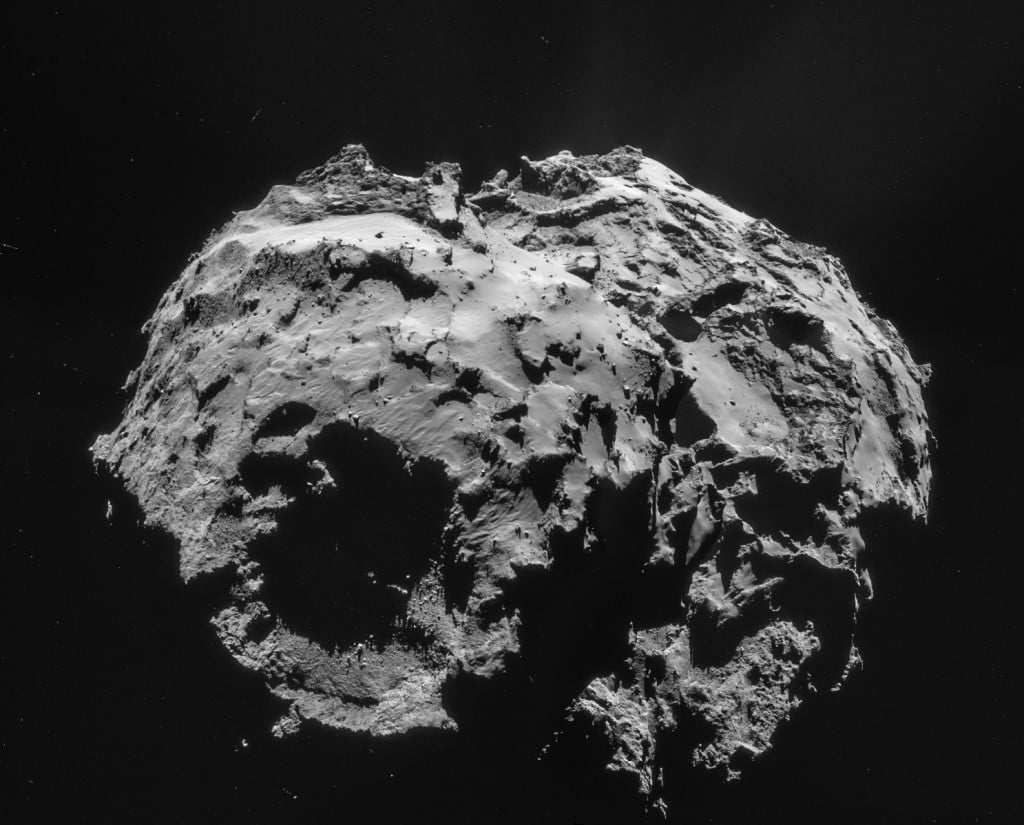Don't forget about Philae! The comet lander made a touchdown a month ago this week on its target, marking the first time we've ever made a soft landing on such a body. Celebrations were quickly mixed with confusion, however, as controllers
realized the spacecraft drifted quite a ways off target
. In fact, we still don't know exactly where it is.
The parent Rosetta spacecraft is working well in orbit and still transmitting images of the comet while Philae hibernates in a shady spot below. This latest image here shows a clear view of where the European Space Agency
thinks
the lander arrived -- somewhere in the rim of that shadowy crater you see up front.
"The internal walls are seen in quite some detail. It is thought that Philae's final touchdown site might be located close to the rim of this depression, but further high-resolution imaging is still being obtained and analyzed to confirm this," the agency wrote in a statement concerning the image of Comet 67P/Churyumov-Gerasimenko.
This is based on data collected from Philae in a brief science surge on the surface. Recently, information based on measured magnetic fields showed the spacecraft likely hit an object --
perhaps a crater rim
-- as it drifted for two hours on the surface, unsecured by the harpoons that were supposed to fire to hold it in place.
[caption id="attachment_117137" align="alignnone" width="580"]
The distortion at bottom of this Dec. 1, 2014 mosaic of Comet 67P/Churyumov-Gerasimenko occured as imagers made image joining adjustments for the comet's rotation and the movements of the Rosetta spacecraft. Credit: ESA/Rosetta/NAVCAM – CC BY-SA IGO 3.0[/caption]
Searches for the lander are ongoing, but it's hard to pick it out on such a boulder-strewn landscape. Yet the agency is doing its mightiest, and has made some progress on the problem since the landing took place. Rosetta caught several glimpses of the
lander during its journey across the surface
. And they have data from an experiment
that communicated between Rosetta and Philae
which could help pinpoint the location.
Rosetta science results have been quiet in the past week, although ESA has released several images of the comet. This comes as the agency has been criticized for its data release policy regarding the mission.
It's a vigorous debate
, with there being examples of more open missions (such as Curiosity) and more closed missions (such as the Hubble Space Telescope) to compare Rosetta's releases with.
As these activities continue, however, Rosetta will remain transmitting information from 67P through at least part of 2015, watching the comet increase in activity as both draw closer to the Sun. Jets and gas are visible already in some of the recent images of the comet, which you can see below.
[caption id="attachment_117138" align="alignnone" width="580"]
Comet 67P/Churyumov-Gerasimenko viewed by the Rosetta spacecraft on Nov. 30, 2014 showing off layered material in the "neck" of the comet. Credit: ESA/Rosetta/NAVCAM – CC BY-SA IGO 3.0[/caption]
[caption id="attachment_117140" align="alignnone" width="580"]
Erupting gas and dust is just visible in the "neck" region of Comet 67P/Churyumov-Gerasimenko in this montage taken Nov. 26, 2014 by the Rosetta spacecraft. Credit: ESA/Rosetta/NAVCAM – CC BY-SA IGO 3.0[/caption]
[caption id="attachment_116733" align="alignnone" width="489"]
Gas and dust stream from Comet 67P/Churyumov–Gerasimenko in this mosaic from the Rosetta spacecraft taken Nov. 20, 2014. Credit: ESA/Rosetta/NAVCAM – CC BY-SA IGO 3.0[/caption]
 Universe Today
Universe Today
